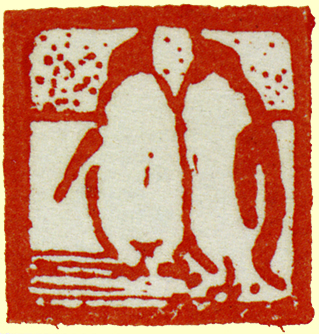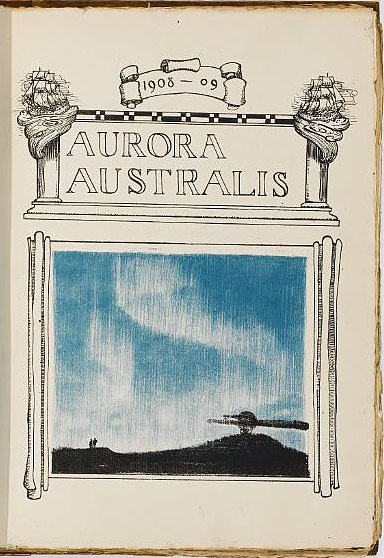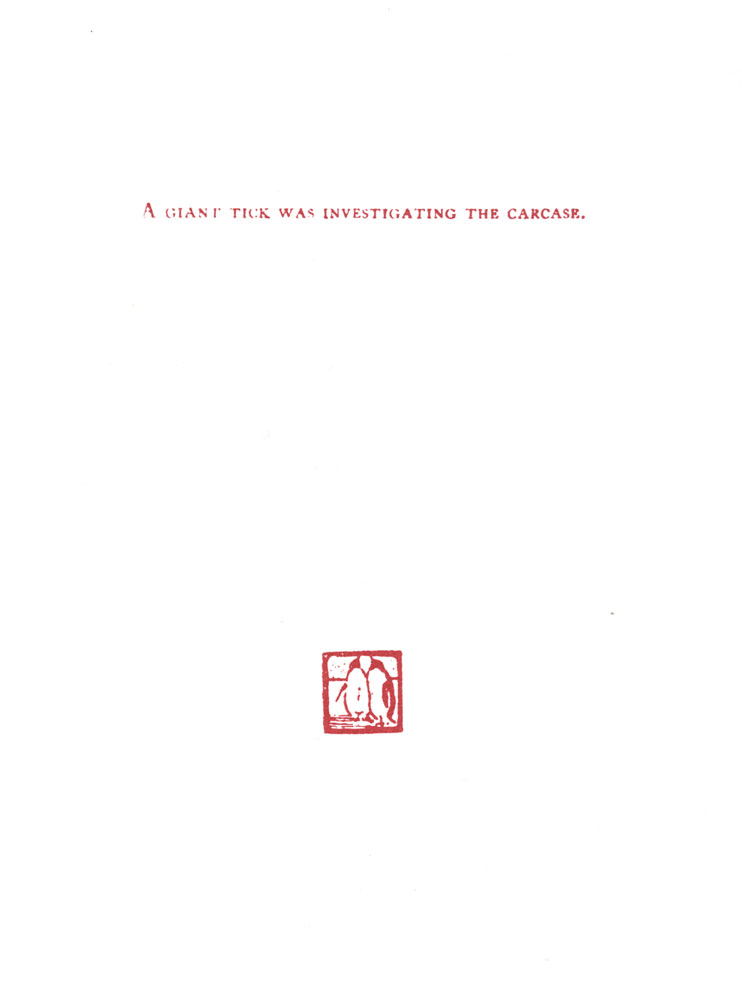AURORA AUSTRALIS

This page gives guidance to those who might be inspecting or collating a copy of the Aurora Australis.
What to look for?
Launched: 15 November 2008.
Last updated: 18 January 2012.
1. Cover Stencilling: Perhaps the best way to identify individual copies of the Aurora is through the stencilling that was used. The boards of the Aurora were literally boards, boards taken from the packing cases of the expedition. These cases were stenciled to indicate contents.
Stencilling should ideally be photographed and identified as to front inside cover or rear inside cover. To my knowledge, no copies have stenciling on the outer covers. Some copies have stenciling on only one cover and a few have no stencilling whatsoever.
If a photograph can't be taken, make a sketch with location and text shown as carefully as possible.
2. Inscriptions: Some copies are signed by Shackleton and/or others associated with the expedition. Some copies have presentation inscriptions as well. Still other copies have no inscriptions of any sort.
It is important to write out all inscriptions separating lines with | and indicating the location (e.g. recto of first blank, etc.). And if there are no inscriptions, it is important to so indicate.
In some instances, inscriptions or letters or other material have been mounted on leaves. These should be treated the same as inscriptions.
Some copies have ownership marks (including bookplates) or other writing, notations, maginalia, call numbers, etc., that are important to record as such marks can establish ownership, etc.
3. Shekels Variant: There are known to be two text variants. These involve a page in the chapter entitled "An Ancient Manuscript." The sixth unnumbered page of this chapter is either an illustration of the Nimrod entitled "Many Shekels Were Needed for the Ship to go Forth" (Variant A) or all text (Variant B), text that does not appear anywhere in Variant A. Variant B appeared first and there are far fewer known instances. Variant A replaced the text of Variant B with the illustration. (For a detailed discussion of this refer to Martin Greene's paper.)


Left: Text Variant A. Right: Text Variant B
4. Title page variants: The color title page of the Aurora has two states (and a handful of copies have title pages that are not colored at all).
Variant A (see below) has a mysterious dark device on the right side. No one has been able to explain what this is or why some copies have it and some others do not. I refer to it, certainly inaccurately, as a "propeller." (Recently it has been suggested that what is depicted is the volcano Mt Erebus and that the device is steam.)
Variant B (see below) does not have this device although where it would be often shows a 'ghosting' effect, suggesting perhaps that the device was removed sometime after printing of the sheet commenced.


Left: Title page Variant A. Right: Title page Variant B
5. Chapter Title Variant: There are two variants of the chapter title sheet that follows the 'Trials of a Messman' as shown in the images. John Millard was given an example of the Variant B sheet pictured by Griffith Taylor who had removed some sheets so printed from the Cape Royds hut and gave them to various people in later years. No example has been found in a copy of the Aurora Australis but it's still worth looking for. (Note the placement of the (?) question mark which differs.) All other separators correspond in design to Variant A.

Left: Variant A. Right: Variant B.
6. Presence of 'Giant Tick' Chapter Title: In a small number of copies, a final printed leaf—"A Giant Tick Was Investigating the Carcase"—is present. Indicate whether this appears or not. (The illustration itself was never thought to exist. However, recently the Scott Polar Research Institute was given two copies of the Aurora on indefinite loan. The once-thought apocryphal illustration appears in one of them. An image of this will be added to this site in late June 2012.)
 7. Running Heads:
7. Running Heads:
a) The running head on the fourth page of the chapter "A Pony Watch' appears AURORA AUSTRALIS,— rather than AURORA AUSTRALIS.— In other words, a comma rather than a period ends the head. No copy has yet been found with a period.
b) The word 'Mount' is lacking in the running head THE ASCENT OF MOUNT EREBUS on the 17th page of this chapter (which begins with able to ease; and ends with came to a, i.e. it reads THE ASCENT OF EREBUS. No copy has yet been found with the word Mount present.
8. Ross Misspelling: Sir James Clark Ross is misspelled 'Sir James Clarke Ross' on the first page of text ('The Ascent of Mount Erebus'). No copy has yet been found with Clark spelled correctly.
9. Illustrations:
a) It has come to light that some copies have tipped-in plates, i.e. the illustration is on a separate smaller sheet that is affixed to a full-sized sheet. Other copies have the same illustration but it appears directly on the full-sized sheet. Probably what happened was that some illustrations were dirty or the edges were imperfect so they were trimmed down and pasted to a full-sized sheet. Indicate whether there are any tipped-in illustrations and give the title of each. (The illustrations that are sometimes tipped-in include but are not necessarily limited to The Messman, In the Stables and Fourteen Good and True.)
b) Does the illustration Struggle? For The Broom appear in sepia or in black & white?
10. Condition: Copies of the Aurora are laced together and individual leaves often become separated from the green cord that holds the leaves and covers together. So separated leaves are one thing to look for.
Sometimes the cord has been replaced by one of another color.
The leather spine often has cracked at the joints, so look for this. (Some copies have had their spines repaired or rebacked; look for the 'Sign of the Penguins' trade mark stamped in blind at the base of the spine and the title at the top.)
Sometimes the boards are cupped or have cracks. This should be noted.
Of course, it's possible that one or more leaves are missing from a particular copy. If the individual pages were numbered this would be easier to determine.
11. Provenance: Provenance is often indicated by inscriptions, bookplates, ownership marks, accompanying letters, catalogues, receipts, etc. Any information on the chain of ownership is useful to know.
12. New points: As new points come to light and they will be included here rather than trying to insert them above.
a) Does the text on the fourth line of the 11th page of the chapter 'The Ascent of Mount Erebus', which begins with the text hanging straight down, read "household gods"? Given the context the intention was almost certainly "household goods". No copies are known to have it as Goods.
b) Does a comma or a period appear after "knees" on the second line of the 13th page of the chapter 'The Ascent of Mount Erebus' which begins with the text all, down the ravine? No copies are known to have it with a comma.
c) Does the angle given on the eighth line of the 14th page of the chapter 'The Ascent of Mount Erebus' which begins with the text When we awoke at 4 a.m. appear as 30° or 34°? There are known to be copies with both angles.
Notes: Enter any comments, observations, facts about the copy not otherwise entered elsewhere.
Source: If personal inspection, give the date. Name of person, title, etc., if by correspondence.
Contacts: Note any contact persons who might be approached for further information.







